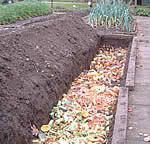 This year we have put all of our soil amending efforts into one of the two veggie beds the house came with. We've airated (we needed to use a pic axe because the soil was so compacted), we've added steer manure and organic mushroom compost. The Boy is on his way to pick up several garbage bags of chicken compost so we can finalize the first veggie bed for the winter.
This year we have put all of our soil amending efforts into one of the two veggie beds the house came with. We've airated (we needed to use a pic axe because the soil was so compacted), we've added steer manure and organic mushroom compost. The Boy is on his way to pick up several garbage bags of chicken compost so we can finalize the first veggie bed for the winter.For the second veggie bed we are going to try trench composting. We've chosen this method because we don't need that second veggie bed for next year (baby steps and all), and we still have a lot of kitchen scraps that the worms can't possibly eat it all.
Photo: Those are our two veggie beds this summer while we were trying to figure out what to do. In the forefront is the bed we have concentrated our work on (ignore the weeds, they are no longer there) to the right is the second bed in which we will be trying trench composting. In the far right top corner (barely visible) is our main compost heap, that should be ready for use this summer.
Quoted from Florida's Online Composting Center-
"Trench Composting is a relatively straight-forward method of composting directly in the soil. This method does not require a bin. Simply dig a trench 8 inches deep in the garden area, fill with 4" of kitchen scraps and backfill with soil.
After a few months, the material will have decomposed sufficiently for planting above the compost trench. For large amounts of material, consider roto-tilling the material into the soil, and waiting a season before planting.
The advantages of trench composting include ease of implementation and its ability to handle kitchen scraps without attracting pests as readily as in sheet composting.
The disadvantages of trench composting include slow rate of decomposition and potential for pests to excavate trenches. Additionally, if the raw materials contain weed seed or plant pathogens, these undesirables will not be destroyed in the trench composting process.
A variant of trench composting was taught to the pilgrims by the Native Americans. You may have heard the story of how Squanto showed the pilgrims how to fertilize their corn crops by burying fish scraps underneath the corn. As the fish composted, nutrients were released for the crop"
More info:
Instructable- not a lot of info, but there is some
Horticulture Blog
Mother Earth News- article on general composting, touches on the trench method
 A picture of trench composting from Garden Organic
A picture of trench composting from Garden Organic


1 comment:
I want to try this. I've buried, ahem, dog waste, for years, but I never thought about burying good compostables in the garden this way. NEAT.
Post a Comment